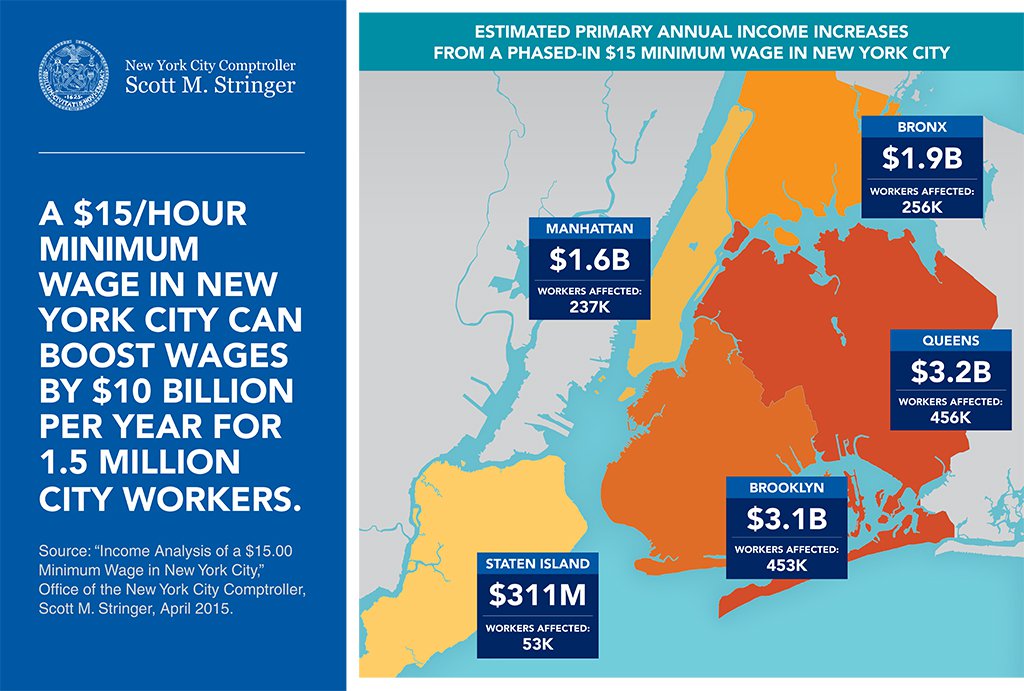Comptroller Stringer Report: Raising Minimum Wage In New York City To $15 Per-Hour Will Put $10 Billion Into The Pockets Of Nearly 1.5 Million Workers

A $15 minimum wage would boost consumer spending, lessen the burden on social assistance programs and benefit students
(New York, NY) — Raising the minimum wage to $15 per-hour in New York City by 2019 would boost wages by $10 billion a year and benefit nearly 1.5 million workers in the City, according to a new Economic Brief released today by Comptroller Scott M. Stringer.
The Comptroller’s report shows how a $15 per-hour minimum wage would impact millions of workers in each borough:
- In Queens, 456,300 workers would see a $3.2 billion annual wage increase;
- In Brooklyn, 453,400 workers would see a $3 billion annual wage increase;
- In the Bronx, 256,300 workers would see a $1.9 billion annual wage increase;
- In Manhattan, 237,100 workers would see a $1.6 billion annual wage increase; and
- In Staten Island, 52,800 workers would see a $311 million annual wage increase.
“Raising the minimum wage is one of the single most effective tools we have to attack income inequality in our City, and there is no reason to delay an increase of up to $15 per-hour,” Comptroller Stringer said. “The question should no longer be whether the minimum wage should be increased in New York City, but by how much. A $15 per-hour wage would put billions into the pockets of working families who need it the most.”
New York City currently has the nation’s highest cost of living and, when adjusted for cost-of-living, the City’s minimum wage is the lowest of any major U.S. city. New York State’s minimum wage is set to rise to $9 per-hour in 2016. Comptroller Stringer’s report analyzes the impact of raising the wage in New York City based on the New York State Assembly’s proposal to increase it to $12.75 per-hour in 2017, $13.75 per-hour in 2018 and to $15 per-hour in 2019.
An increase in the minimum wage would benefit workers in fast-growing sectors of the City’s workforce. Overall, low-wage sectors have increased by 3.9 percent annually from 2009 to 2014. The three largest low-wage sectors – food services, retail trade and home health care – have grown at a 5.5 percent rate during that same period. Workers in these sectors would see average weekly wage increases ranging from $113 to $149 by 2019.
A raised minimum wage would have wide-ranging impacts on the amount spent on social assistance programs and increase the amount of taxes collected by the City. Comptroller Stringer estimates that a $15 per-hour minimum wage would decrease the amount spent on individuals who are eligible for Food Stamps and Medicaid by $200 to $500 million annually. Households receiving more income from a raised minimum wage would also be expected to pay approximately $250 million in additional New York City income taxes.
The Comptroller estimates that a $15 per-hour minimum wage would lead to an average annual household income increase of approximately $10,000. Based on trends outlined in the Consumer Expenditures Survey, with this additional income, impacted New York City households could be expected to spend annually:
- $1,100 to $1,800 more on housing;
- $300 to $600 more on groceries;
- $200 to $400 more on entertainment;
- $200 to $300 more on healthcare; and
- $200 to $300 more on food consumed outside the home.
Additionally, the report found that increasing the wage would reduce the number of households earning less than $30,000 by 169,000 as many of these families would move into higher-income brackets. At the same time, the number of households earning between $10,000 and $30,000 would be 44 percent lower. Significantly, a $15 per-hour minimum wage would reduce the number of New Yorkers who spend more than half of their income on rent by over 90,000.
Thirteen percent of those benefiting from a $15 per-hour wage would be New York City students. From 1980 to 2011, the federal minimum wage increased by about 134 percent, while the cost of private higher education grew by 409 percent. A $15 per-hour wage would nearly close the gap between the minimum wage and college costs that has widened in the last thirty-five years.
Other states and cities across the nation have moved to raise their minimum wages. Last year Seattle and San Francisco enacted minimum wages that phase-in to $15.00 per-hour, and other cities have also increased their local wage. In 2014, Connecticut and Maryland approved increases of up to $10.10 per-hour. Vermont’s minimum wage will phase-in to $10.50 per-hour in 2018 and Massachusetts’ minimum wage will rise to $11 per-hour by 2017.
“We can boost our economy and help millions of New Yorkers by raising the minimum wage. With about two and a half months left in the current legislative session in Albany, there is more than enough time to get this done so it can take effect next year. When it comes to increasing economic opportunity, New York City must be a national leader. It’s time for us to join Seattle, San Francisco and many other cities in doing what’s right for working men and women,” Stringer said.
###